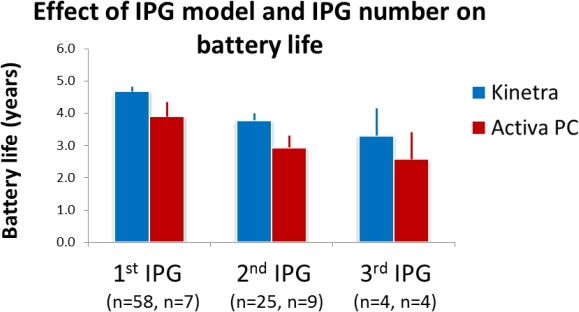Session Information
Date: Monday, June 20, 2016
Session Title: Surgical therapy: Parkinson's disease
Session Time: 12:30pm-2:00pm
Location: Exhibit Hall located in Hall B, Level 2
Objective: To investigate the influence of the number of implantable pulse generator (IPG) replacement surgeries and the IPG model on battery life in bilateral STN DBS for PD.
Background: In our clinic, some non-rechargeable IPGs have recently been replaced due to earlier than anticipated battery depletion. Longevity in replacement versus 1st IPG has been reported to be shorter in pallidal DBS for dystonia but similar comparisons for STN-DBS or PD have not been reported and differences between IPG models are not known.
Methods: Seventy-six PD patients treated with bilateral STN-DBS with at least one IPG battery replacement were identified from a database of patients followed up at the Movement Disorders Institute, Sheba Medical Center. 8 patients were excluded due to battery replacement for reasons other than end of life, IPG model other than Kinetra or Activa PC or insufficient data. Data from 68 patients and 107 IPGs (87 Kinetras, 20 Activa PCs), 1st implantation from 01-05-99 to 18-04-13, were analyzed using Linear Mixed Models, SPSS IBM v.19.
Results: The data demonstrated a trend of longer battery lives for Kinetra vs. Activa PC, with 1st IPG lasting an average of 4.7 ± 0.2 (standard error) years with Kinetra vs. 3.9 ± 0.4 years with Activa PC; the 2nd IPG lasting 3.8 ± 0.2 years vs. 2.9 ± 0.4 years, and the 3rd IPG lasting 3.3 ± 0.8 years vs. 2.6 ± 0.8 years respectively, p=0.11.  In addition, there was a statistically significant decrease in battery life with increasing number of previous battery replacements: p<0.03. There was no IPG model * IPG number interaction effect: p=0.99.
In addition, there was a statistically significant decrease in battery life with increasing number of previous battery replacements: p<0.03. There was no IPG model * IPG number interaction effect: p=0.99.
Conclusions: We found a statistically significant effect of the number of IPG replacements on IPG longevity. This may be due to hardware factors or programming parameters with higher energy consumption. In addition we found a trend of a shorter longevity for Activa PC vs. Kinetra. This may be related to differences in the batteries themselves and their programming, e.g., the use of multiple program groups with frequent changes, please see our other poster for an in depth review of stimulation parameters in a subset of this sample.
To cite this abstract in AMA style:
S.D. Israeli-Korn, S. Tessler, G. Yahalom, S. Benizri, O.S. Cohen, C. Shabat, H. Strauss, N. Warmann-Alaluf, E. Stein, Z. Zibly, R. Spiegelman, S. Hassin. Implantable pulse generator (IPG) longevity decreases following each replacement surgery in Parkinson’s disease (PD) patients treated with bilateral sub-thalamic nucleus deep brain stimulation (STN-DBS) [abstract]. Mov Disord. 2016; 31 (suppl 2). https://www.mdsabstracts.org/abstract/implantable-pulse-generator-ipg-longevity-decreases-following-each-replacement-surgery-in-parkinsons-disease-pd-patients-treated-with-bilateral-sub-thalamic-nucleus-deep-brain-stimulation-stn-db/. Accessed December 28, 2025.« Back to 2016 International Congress
MDS Abstracts - https://www.mdsabstracts.org/abstract/implantable-pulse-generator-ipg-longevity-decreases-following-each-replacement-surgery-in-parkinsons-disease-pd-patients-treated-with-bilateral-sub-thalamic-nucleus-deep-brain-stimulation-stn-db/
